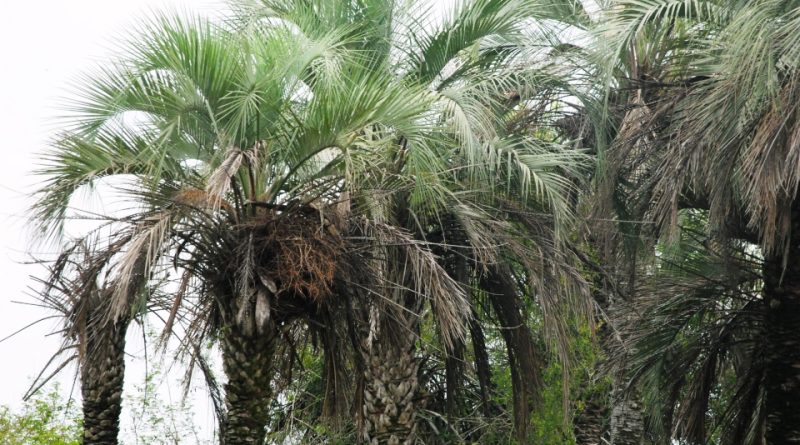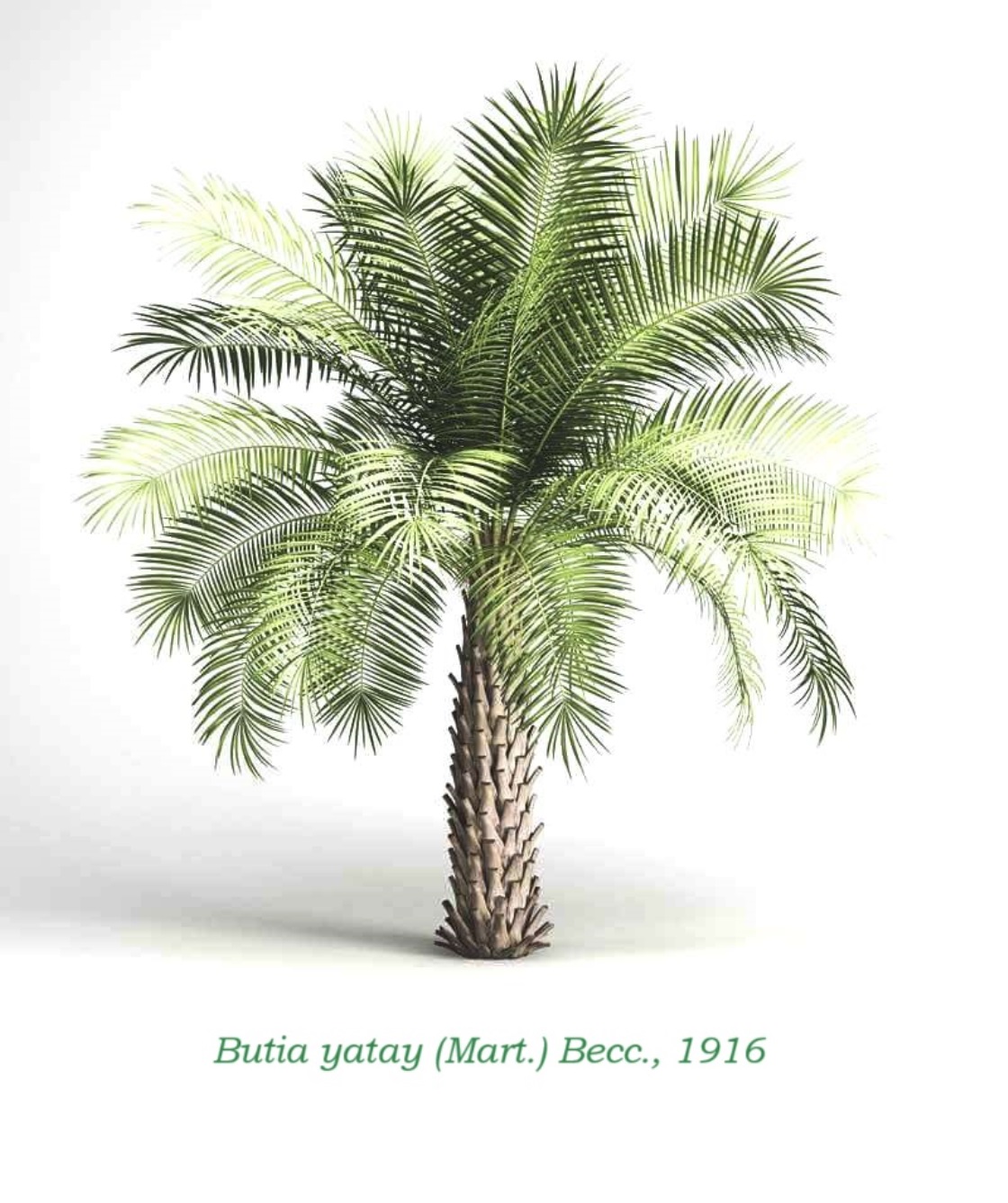Butia yatay
Butia yatay
The yatay palm or jelly palm (Butia yatay (Mart.) Becc., 1916) is an arboreal species belonging to the Arecaceae family.
Systematic –
From a systematic point of view it belongs to:
Eukaryota domain,
Kingdom Plantae,
Division Magnoliophyta,
Class Liliopsida,
Subclass Arecidae,
Order Arecales,
Arecaceae family,
Subfamily Arecoideae,
Cocoseae Tribe,
Subtribe Butiinae,
Genus Butia,
Species B. yatay.
The term is basionym:
– Cocos yatay Mart..
The terms are synonymous:
– Butia capitata subsp. yatay (Mart.) Herter;
– Butia missionera Deble & Marchiori;
– Butia ponae (Hauman) Burret;
– Butia quaraimana Deble & Marchiori;
– Calappa yatay (Mart.) Kuntze;
– Syagrus yatay (Mart.) Glassman.
Etymology –
The term Butia derives from the Portuguese diction of the indigenous name which means thorny, toothed, in reference to the thorns present on the petioles.
The specific epithet yatay is adopted from the Guarani language word for such palms, yata’i, which in turn refers to the small, hard fruit.
Geographic Distribution and Habitat –
The Butia yatay is a Butia palm native to southern Brazil, Uruguay and northern Argentina.
In Brazil it grows naturally only in the southernmost state of Rio Grande do Sul, and there only in the municipalities of Giruá and Quaraí. In Argentina it is present in the central-northern provinces of Chaco, Corrientes, Entre Ríos, Misiones (in the municipalities of Candelaria and San Ignacio) and Santa Fe. In Uruguay it is present only in the west, in the departments of Paysandú and Río Negro.
The largest public protected area where this species is present is the El Palmar National Park, located in the Argentine province of Entre Ríos, where it occupies more than 8,500 hectares, while the largest reservoir of this species in private state property is preserved in the Wildlife Refuge, La Aurora del Palmar Multipurpose Provincial Reserve, with more than 400 hectares.
Bauermann et al. investigated the possibility of using palm pollen, including this species, in palynology, to try to provide more detail on ancient habitat changes in the state of Rio Grande do Sul in Brazil by monitoring changes in palm distribution and abundance , but they were unable to provide many details on the matter.
Its habitat is often that of extensive colonies in the prairies (pampas) on predominantly sandy soils, from acidic to slightly alkaline, up to about 500 m above sea level.
Description –
Butia yatay is an evergreen palm with a solitary trunk.
The trunk often grows on a slope and is between 3 and 16 metres, exceptionally 18 meters tall, although it usually grows shorter in Brazil (up to 8 metres).
The trunks grow from 30 to 55 cm in diameter, usually retaining a layer of old leaf bases that are not easily shed naturally and which remain persistent for many years.
The foliage is made up of strongly and elegantly arched, imbricate pinnate leaves, 1.6-2.5 m long, with rigid, linear leaflets with acute apex, arranged regularly along the rachis and facing upwards to form a V; petiole 0.6-0.7 m long with margins provided with scattered spines of about 3 cm in length at the base, decreasing towards the apex. The leaflets are 70-80 cm long in the middle part and 2-2.4 cm wide, bluish gray in colour.
The developing inflorescence is protected within a woody, glabrous spathe, slightly striated and 105–135 cm long, with the swollen part of this spathe 40–110 cm long and 7–14 cm wide. The branched inflorescence has a peduncle (stem) 40–75 cm long and 1.5–2.2 cm wide. The inflorescence rachis is 40–72 cm long and has 68–155 rachillae (branches) 16–72 cm long.
The flowers are yellow, yellow-purple, greenish-yellow or entirely purple. The staminate (male) flowers are 9-10 mm long; the pistillate (female) flowers measure 13–17(–18)mm.
The flowers are arranged in a triad (a female flower between two male ones), except in the terminal part where only male flowers are present. The inflorescence presents the phenomenon of protandry (the male flowers ripen before the female ones) which favors cross-fertilization.
Compared to other palms in the region, Butia yatay has the largest pollen grains on average. They are bilaterally symmetrical, suboblate-shaped, pyriform (pear-shaped) at the end, and monofurrowed. The surface is covered with tiny lattice patterns 2 μm wide.
The fruits are the largest of the genus and are ovoid drupes of yellow or yellow-orange color when ripe with a prominent pointed apex, 3.5-4.8 cm in length and 2.2-2.8 cm in diameter, with woody, hard, ovoid endocarp with a sort of “beak” at the apex, 2.2-3 cm in length and 0.8-1.3 cm in diameter, containing 1-3 oil seeds.
Cultivation –
Butia yatay is an evergreen plant that is harvested in the wild for local use as food and medicine.
Today it is planted for ornamental purposes and has been introduced for this purpose in other subtropical regions of the world. It is easily confused with the closely related species B. capitata, also known as yatay or butiá, which is shorter and has edible fruit.
This species is the most impressive among the Butia, but rare in cultivation, it deserves greater diffusion for its notable ornamental and landscape characteristics and its adaptability to different climatic conditions, from tropical to warm temperate, even humid, where as an adult it can resist temperatures, if exceptional and short-lived, down to around -8 °C, a few degrees less if dry.
For cultivation it requires full sun and is not particularly demanding regarding the soil, from acidic to slightly alkaline, as long as it is draining, although it prefers sandy, deep soil, rich in organic substance. It resists well rooted periods of dryness, but grows faster if periodically irrigated in climates characterized by long hot and dry summers.
In the wild it grows in climates with a pronounced dry season, but can be successful in a range of conditions, from dry subtropical zones to warm temperate zones with moderate rainfall.
It fruits abundantly in summer and the seeds germinate in the wild in spring or autumn.
This plant reproduces by seed in draining soil kept constantly humid at a temperature of 25-28 °C, with variable germination times, from 3 months to over a year; growth, particularly in the juvenile phase, is slow.
Customs and Traditions –
Butia yatay is a palm known by various common names; among these we remember: jatay palm, jelly palm, yatai palm (English); butiá, coco, yatay palm, yatay (Argentina); butiá, butiá-yataí, coquiero jataí, yataí (Brazil); yatay palm (Uruguay).
At 18 m tall, the Butia yatay of Argentina, Brazil and Uruguay is the tallest species of the genus.
In their places of origin the fruits, even if considered of lower quality than those of Butia odorata and Butia eriospatha, are consumed fresh or used to prepare jams, juices and alcoholic drinks, they are also an important resource for the local fauna. The leaves, rich in resistant fibres, are used to make various artistic and commonly used craft objects. Finally, seed oil has good characteristics for its use as a biofuel.
Seeds (or rather, nuts) are harvested in Brazil for the international ornamental plant industry.
It is also commonly grown and sold in Japan as an ornamental lawn plant.
From an ecological point of view, the Butia yatay is believed to be one of the natural hosts of the larvae (caterpillars) of the giant diurnal moth Paysandisia archon which attacks the pith of this palm, together with many other palm species, at least in Europe where the moth is it is naturalized after probably being introduced from Argentina hidden in the trunks of B. yatay and Trithrinax campestris in lots of palms imported for ornamental horticulture. An infestation can kill the palm. The moth prefers palm genera with hairy stems as the fiber is used in the construction of the cocoon for the pupa; in Europe it prefers above all Trachycarpus, but also Trithrinax or Chamaerops.
Regarding its conservation status, in 2008 it was classified in Brazil as “data deficient” by the federal Ministério do Meio Ambiente. In 2012, the conservation status in Brazil was assessed as “vulnerable” by the Centro Nacional de Conservação da Flora. Although it occurs across a vast range, both the size and quality of the remaining habitat are threatened due to the expansion of forestry and agricultural activities.
Preparation Method –
Butia yatay is a plant that has long been used for food purposes.
The very young apical buds are used as food; however, removing the shoot kills the tree as it is unable to produce lateral shoots.
The fruit is eaten raw and made into juice. It is aromatic, with thick, succulent, fibrous pulp, with an acid-sweet flavour.
The fruits are used to make brandy.
You can also eat the seed kernel.
The seed is anthelmintic.
Guido Bissanti
Sources
– Acta Plantarum – Flora of the Italian Regions.
– Wikipedia, the free encyclopedia.
– GBIF, the Global Biodiversity Information Facility.
– Useful Tropical Plants Database.
– Conti F., Abbate G., Alessandrini A., Blasi C. (ed.), 2005. An annotated checklist of the Italian vascular flora, Palombi Editore.
– Pignatti S., 1982. Flora d’Italia, Edagricole, Bologna.
– Treben M., 2000. Health from the Lord’s Pharmacy, Advice and experiences with medicinal herbs, Ennsthaler Editore.
Photo source:
– https://inaturalist-open-data.s3.amazonaws.com/photos/120315818/original.jpeg
Attention: Pharmaceutical applications and food uses are indicated for informational purposes only, they do not represent in any way a medical prescription; we therefore decline any responsibility for their use for healing, aesthetic or food purposes.


